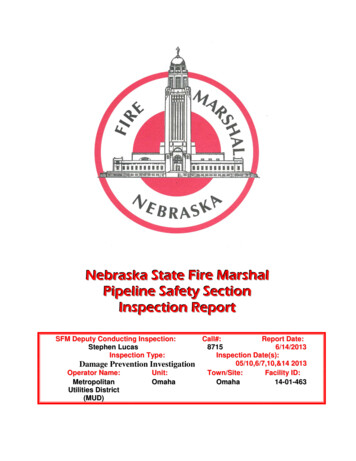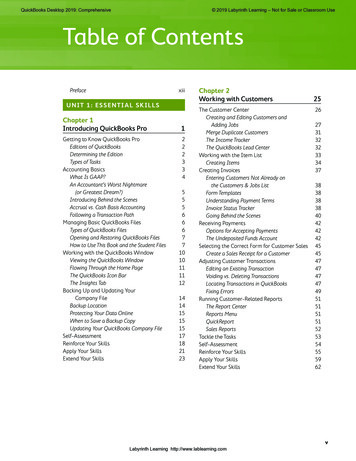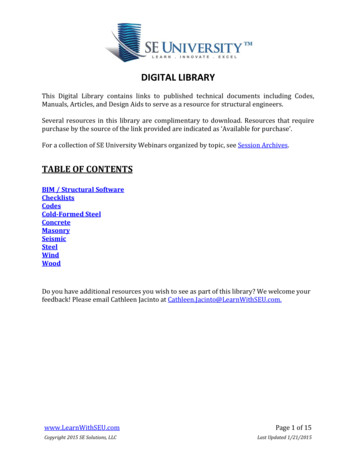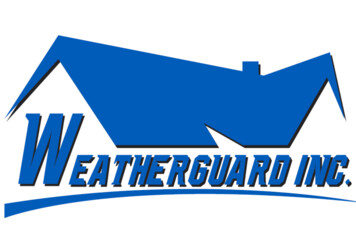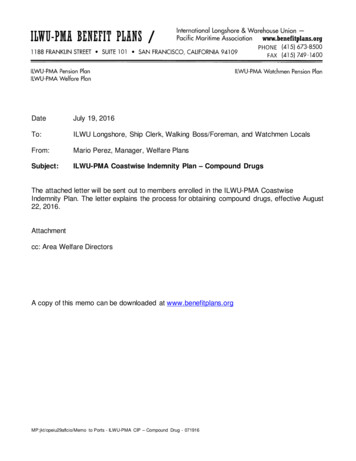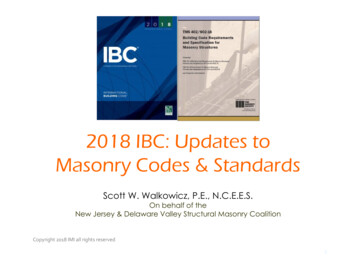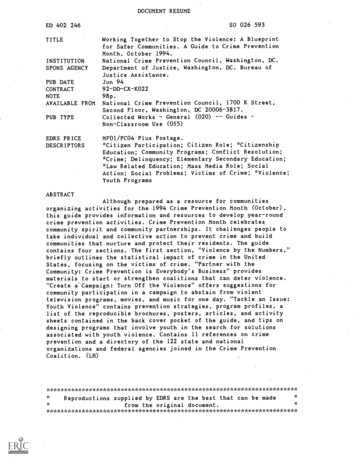
Transcription
DOCUMENT RESUMESO 026 593ED 402 246TITLEINSTITUTIONSPONS AGENCYPUB DATECONTRACTNOTEAVAILABLE FROMPUB TYPEWorking Together to Stop the Violence: A Blueprintfor Safer Communities. A Guide to Crime PreventionMonth, October 1994.National Crime Prevention Council, Washington, DC.Department of Justice, Washington, DC. Bureau ofJustice Assistance.Jun 9492-DD-CX-K02298p.National Crime Prevention Council, 1700 K Street,Second Floor, Washington, DC 20006-3817.GuidesGeneral (020)Collected WorksNon- Classroom Use (055)EDRS PRICEDESCRIPTORSMF01/PC04 Plus Postage.*Citizen Participation; Citizen Role; *CitizenshipEducation; Community Programs; Conflict Resolution;*Crime; Delinquency; Elementary Secondary Education;*Law Related Education; Mass Media Role; SocialAction; Social Problems; Victims of Crime; *Violence;Youth ProgramsABSTRACTAlthough prepared as a resource for communitiesorganizing activities for the 1994 Crime Prevention Month (October),this guide provides information and resources to develop year-roundcrime prevention activities. Crime Prevention Month celebratescommunity spirit and community partnerships. It challenges people totake individual and collective action to prevent crime and buildcommunities that nurture and protect their residents. The guidecontains four sections. The first section, "Violence by the Numbers,"briefly outlines the statistical impact of crime in the UnitedStates, focusing on the victims of crime. "Partner with theCommunity: Crime Prevention is Everybody's Business" providesmaterials to start or strengthen coalitions that can deter violence."Create a*Campaign: Turn Off the Violence" offers suggestions forcommunity participation in a campaign to abstain from violenttelevision programs, movies, and music for one day. "Tackle an Issue:Youth Violence" contains prevention strategies, program profiles, alist of the reproducible brochures, posters, articles, and activitysheets contained in the back cover pocket of the guide, and tips ondesigning programs that involve youth in the search for solutionsassociated with youth violence. Contains 11 references on crimeprevention and a directory of the 122 state and nationalorganizations and federal agencies joined in the Crime PreventionCoalition. *************************Reproductions supplied by EDRS are the best that can be madefrom the original ******************************
ingVie6JvcA-"PERMISSION TO REPRODUCE ANDDISSEMINATE THIS MATERIALHAS BEEN GRANTED BYTO THE EDUCATIONAL RESOURCESINFORMATION CENTER (ERIC)U.S. DEPARTMENT Of EDUCATIONOffice of Educational ROSIrCh and Improvement1.EDUCATIONAL RESOURCES INFORMATIONCENTER (ERIC11pahis document haS been reproduced asreceived from the person or Organizationoriginating it0 Minor changes have been made to improvereproduction Quality.IL Points of view or opinions stated in thin doc u-went do riot necessarily represent officialOERI position or policy.a BLuePRint for safer communities6fAmx/2 ,Rtvvemb bey,. moth, oc4,444. imtBEST COPY AVAgLAB1 E
Publication Funded byittBureau of Justice AssistanceOffice of Justice ProgramsU.S. Department of JusticeThis publication was substantially funded through Cooperative Funding Agreement No.92-DD-CX-K022 from the Bureau of Justice Assistance, Office of Justice Programs,U.S. Department of Justice. Opinions are those of NCPC or cited sources and do not necessarily reflect U.S. Department of Justice policy or positions. The Bureau of Justice Assistanceis a component of the Office of Justice Programs, which also includes the Bureau of JusticeStatistics, the National Institute of Justice, the Office of Juvenile Justice and DelinquencyPrevention, and the Office for Victims of Crime.The National Crime Prevention Council is a private, nonprofit, tax-exempt [501(c)(3)]organization whose principal mission is to enable people to prevent crime and build safer,more caring communities. In addition to its publications, trainings, demonstration programs,and comprehensive planning efforts, NCPC acts as secretariat for the CrimePrevention Coalition and manages the National Citizens' Crime PreventionCampaign, which is substantially funded by the Bureau of Justice Assistance,Office of Justice Programs, U.S. Department of Justice.The McGruff symbol and the "Take A Bite Out Of Crime" slogan are registeredTAKE A BITE OUT OFtrademarks of the National Crime Prevention Council.The Crime Prevention Coalition is the national sponsor of Crime Prevention Month on behalfof its 122 member organizations, which include federal agencies, national organizations, andstate crime prevention programs and associations committed to reducing and preventing crime.CallaAcknowledgementsKey NCPC staff Jacqueline Aker, Editorial/Research Associate; Robbye Braxton-Mintz, ProgramSpecialist; Judy Kirby, Executive Assistant; Kathryn Mills, intern; Mary Jo Marvin, Editor, Catalyst andSpecial Projects; Jean O'Neil, Managing Editor and Director of Research; Marty Pociask, ProductionEditor; and Faye Warren, Director, Coalition and State Services.For the Crime Prevention Coalition: Domingo Herraiz, Ohio Crime Prevention Association; DonPerretz, Wisconsin Department of Justice; Antony Queen, Crime Prevention Division, North CarolinaDepartment of Crime Control and Public Safety; Nathaniel Robinson, Wisconsin Department ofAdministration; and David Rost, Missouri Department of Public Safety.For the Mom Off the Violence (TOV) Campaign: Rosie Griep, President, Minnesota Crime PreventionPractitioners, Inc.; Sheila Miller, Steering Committee Chair, TOV Campaign; Leah Skurdal, TOV ProjectCoordinator, Minnesota Citizens Council on Crime and Justice.A special thanks to John A. Calhoun, NCPC's Executive Director, and to Robert H. Brown, Jr., NCPC'sProgram Manager at the Bureau of Justice Assistance, for their expertise and continued support. 1994National Crime Prevention Council1700 K Street, NW, Second FloorWashington, DC 20006-3817Document Design: Molly McCaffrey, NCPCPrinting: Presstar, Inc.Materials in this booklet may be reproduced as-is for nonprofit community crime and drugprevention activities, not for sale.Printed in the United States of AmericaJune 1994
Table of Contents2Violence by the NumbersCrime Prevention Month Celebrates Community Spirit4Partner With the CommunityCommunity Partners Bring Diverse Resources to Prevention ProgramsCommunities Commit to Stopping the Violence Through a Proclamation566789A Sample ProclamationA Sample Press ReleaseEveryone Knows McGruff!Celebrating Crime Prevention Month in Milwaukee: A Case StudyWorking With VolunteersMore Ideas for Celebrating Crime Prevention MonthHelpful Resources1212Create a Campaign: /Urn Off the Violence131011How It All StartedPractical ConsiderationsSeven Guiding PrinciplesWorking With Community PartnersA Sample Press ReleaseCelebrating TOV in MinnesotaTOV's OrganizationHelpful ResourcesTtickle an Issue: Youth ViolenceViolence Prevention StrategiesWorking With YouthPrograms That WorkReaching Out to Youth During Crime Prevention MonthHelpful Resources1314141516171818McGruff Educational Products Help You "Take A Bite Out Of Crime"Special Events CalendarSelected ReadingsCrime Prevention Coalition26281920202125253132Look for .Look for the more than 25 reproducible brochures, posters, and articles in the backpocket. Selected and designed to complement each section of the guide, they're invaluable tools to help spread your crime and violence prevention messages.,4BEST COPY AVARABLE
EverywhereIRoughly one-fifth (22 million) of the nation's households were affected by crimein 1992, a smaller percentagethan in any other year sincethe Department of Justicestarted its National CrimeVictimization Survey in 1975.(Bureau of Justice Statistics,Crime and the Nation'sHouseholds, 1993)Overall, serious crimereported to the policedeclined 3% in 1993. Theproperty crimes of burglary,larceny-theft, motor vehicletheft, and arson dropped 3%,while the violent crimedecreased only 1% from1992. (FBI, Uniform CrimeReports, 1993)I People armed with handguns committed a record930,700 violent crimes in1992, and also set a record of917,500 for use of handgunsin nonfatal crimes. This isalmost 50% higher than theaverage for the previous fiveyears. (BJS, Guns and Crime,1994)Between 1987 and 1991,arrests of juveniles for violent crimes increased 50%twice the increase for persons 18 years of age or older.Most alarming, juvenilearrests for murder increased85%, compared with 21% forthose age 18 and older.(Office of Juvenile Justiceand Delinquency Prevention,Juveniles and Violence: JuvenileOffending and Victimization,1993)One-third of the participants in a survey of humanresource professionals reported that their workplace experienced a violent incident inthe past five years and thatthe frequency of such incidents is on the rise. (Societyfor Human ResourcesManagement, 1993)1'39% of all victimizations,50% of violent victimizations,30% of personal thefts, and41% of all household crimeswere reported to the police in1992. (BJS, CriminalVictimization in the UnitedStates, 1994)Who Arethe Victims?IEvery day 15 childrenunder the age of 19 are killedaccidentally or intentionallyby gunfire, and many moreare injured. (Centers forDisease Control andPrevention, National Centefor Health Statistics, 1993)I The violent death rate(homicide, suicide, and accidents) among youth ages 15to 19 increased 13% between1985 and 1991. This is duealmost entirely to a doublinin the incidence of teenagehomicide victims since 198because auto-related fataliti shave declined steadily. (K.Count Data Book, 1994)ResourcesBureau of Justice Statistics (BJS),Office of Justice Programs, U.S.Department of Justice.Crime and the Nation's Households,1992 (NCJ-143288), 1993Criminal Victimization in theUnited States (NCJ-145125), 1994Guns and Crime by Michael R.Rand (NCJ-147003), 1994Highlights From 20 Years ofSurveying Crime Victims (NCJ144525), 1993Violence Against Women by Dr.Ronet Bachman (NCJ-14525),19937b obtain the reports listed above contact the National Criminal JusticeReference Service, Box 6000, Rockville,MD 20850, 800-851-3420 or the Bureauof Justice Assistance Clearinghouse at800-688-4252.Centers for Disease Control andPrevention, U.S. Public HealthService, 1600 Clifton Road, NE,Atlanta, GA 30333.Center for the Study of SocialPolicy, Kids Count Data Book, 1994,1250 Eye Street, NW, Suite 503,Washington, DC 20005.Federal Bureau of Investigation,Uniform Crime Reports, U.S.Department of Justice, CriminalJustice Information Service
At HomeIIn 1993, almost 3 millionchildren in the United Stateswere reported to local authorities or child protective services for child abuse andneglect, an increase of 2.5%from 1992. (NationalCommittee to Prevent ChildAbuse)I Being abused or neglectedas a child increases the likelihood of arrest as a juvenileby 53%, as an adult by 38%,and for a violent crime by38%. (National Institute ofJustice, The Cycle of Violence,1992)Black male teenagers (12o 19 years old) are more likey to be violent crime victimshan any other group. Theirtverage annual rate is 113 vicimizations per 1,000 resi-lents, almost one in nine)lack teenagers. For whitenale teenagers the rate was)0 per 1,000, about one in;leven. (BJS, Highlights From.?.0 Years of Surveying CrimeVictims, 1993)V Women most vulnerable toiiolent crime are black,Hispanic, young, and nevermarried; have lower family.ncome and lower education.evels; and live in centralI Between 20% and 25% ofthe adult women in theUnited States more than 12million women are at riskof being abused by a maleintimate. (Violence inAmerica: A Public HealthApproach, 1991)I More than two-thirds ofthe rapes and assaults againstwomen were committed bysomeone they knew. (BJS,Violence Against Women,1993)Office of Juvenile Justice andDelinquency Prevention (OJJDP),National Committee to PreventOffice of Justice Programs, U.S.Department of Justice.60604.National Institute of Justice (NIJ),Office of Justice Programs, U.S.Department of Justice.The Cycle of Violence, by CathySpatz Widom, 1992American Thacher Survey,1993, Metropolitan Life)More than one-tenth(11%) of America's publicschool teachers say they havebeen victims of acts of vio-lence that occurred in oraround school. Virtually allinvolved students. (TheAmerican Thacher Survey,1993, Metropolitan Life)More than one-tenth(13%) of students say theyhave carried a weapon toschool at one time. This isconsistent among urban, suburban, and rural students.(The American ThacherSurvey, 1993, MetropolitanLife)I One in four students,regardless of school level orachievement, feels that violence has lessened the quality of education in his or herschool. (The AmericanMetropolitan Life)20535.Child Abuse, 332 S. MichiganAvenue, Suite 1600, Chicago, ILINearly one-fourth (23%)of America's public schoolstudents say they have beenthe victim of an act of violence in or around school.The most common aggressiveacts are pushing, shoving,grabbing and slapping, verbalinsults, and threats. (TheThacher Survey, 1993,(BJS, Violence AgainstWomen, 1993)Division, FBI/GRB, Washington, DCAt SchoolJuveniles and Violence: JuvenileOffending and Victimization byBarbara Allen-Hagen andMelissa Strickmund, 1993The Metropolitan Life Survey of theAmerican Racher, 1993, conductedby Louis Harris and Associates.Available while supplies last from:METLIFE, The American TbacherSurvey, Area 12H, 1 MadisonAvenue, New York, NY 10010.Washington Street, Alexandria, VAViolence in America: A Public HealthApproach, edited by Mark L.Rosenberg and Mary Ann Fenley,New York: Oxford University Press,22314-1997.1991.The Society for Human ResourceManagement, 606 NorthBEST COPY AMIABLE
Partner Withthe CommunityCfifthiL ?Ao.ve,n3MmtkuCelebrates Community SpiritTales of too many young lives lost, too many communities frozen by fear, and too much violence on thestreets fuel a national consensus that current levels ofcrime are intolerable. The media's intense coverage ofrandom and seemingly senseless killings also feeds awave of fear sometimes unsubstantiated by statistics.Recent reports from the FBI and the U.S. Bureau ofJustice Statistics show decreases in violent crime andtheft.Even so, the scope of the problem is enormous. Onein four U.S. households experiences violent or property crime each year. This reality, coupled with widespread fear of crime, extracts a deadly toll. Peoplewithdraw from public places and community activitiesbecause they fear for their safety. Young people worryabout harassment or assault on the way to and fromschool, and as they try to learn in school. Parentswon't let children play out of their sight. In the wordsof a Washington, DC, resident surveyed by theWashington Post, "We've got bars on our windows andbars on our doors. Sometimes I wonder, are we locking people out or locking ourselves in?""We have two laudable, but distinct traditions in theUnited States: one symbolized by the individual standing proud and alone, the other by barn raising, a stirring collective effort to get a massive job done," saysJack Calhoun, NCPC's Executive Director. "Crime'sgreatest deterrent is not a loose collection of me's, buta vital community whose residents think first of we."Sponsored by the Crime Prevention Coalition eachOctober, Crime Prevention Month celebrates community spirit and community partnerships. It challengespeople to take individual and collective action to prevent crime and build communities that nurture andprotect their residents.7Among the many "tools" inthis section are a proclamation, a sample pressrelease, suggestions onidentifying communityresources, and tips onboth planning and carrying out a partnership-based community celebration. You'll alsofind information on workingwith volunteers, coordinatingwith other national observances,useful statistics, communityaction ideas, and resources.Create a Campaign"Thrn Off the Violence" (TOV)campaign has two goals: to makepeople aware of nonviolent waysto deal with anger and conflict,and to help both adults and children realize that violent entertainment creates a climate thatfosters the acceptability of violence. On Run Off the ViolenceDay, October 27, 1994, peopleare asked to turn off violent television programs, not listen toviolent music, not go to violentmovies or rent violent videos,and to engage in alternativeactivities that are both nonviolent and constructive. Hopefully,TOV Day will help catalyze significant changes in attitudes andbehavior all year long.Tackle an Issue:Youth ViolencePrevention strategies, programprofiles, and reproduciblebrochures address gun violence,alcohol and drug prevention,school crime, vandalism, youthservice, bullies, conflict management, and children home alone.Tips on designing programs thatwork with young people andideas for Crime PreventionMonth projects conclude thesection.
PArtNerwith the ComMUnityCiAnticRw.peomi)m iseverybudy'sbusinessneighborhoods, an upsurge in gun ownership, a numb-Every day, we see the visible costs of crime a concrete wall built around a playground to deflect straybullets, security guards patrolling shopping malls, graffiti that signals gang turf boundaries as it defacesness to violence that pushes a teenager's murder tothe newspapers' back pages.Communities begin to fall apart in the face of growingcrime. People won't attend night meetings or classesbecause they fear for their safety. In schools, anxieties about assaults, bullies, and guns make it harderto learn and to teach. Businesses shorten their hoursor close; the elderly become imprisoned in theirhomes. In this climate, individuals start to lose theirsense of community and no longer feel responsible forits well-being.Things change for the better when fear, anger, andoutrage turn into action, when determination replacesdespair, and when individuals realize that every stepforward counts from improving a home's securityand joining a Neighborhood Watch to helping out atthe local school. The organizing experiences of bothgovernment-funded demonstration programs andsmall grassroots initiatives clearly show that effectivecommunity crime prevention efforts must involve allelements of the community. Crime Prevention Monthoffers a unique opportunity to start or strengthencoalitions that can tackle violence with vision, energy,and commitment.The problems that lie atthe roots of crime arepoverty, drugs, and thecollapse of the family unit.Obviously these are notsmall problems withinthemselves, and to haveany effect on them weneed the cooperation ofthe entire community.3feach of us donated a fewhours a week to organizations that are already outthere fighting for ourfuture, our efforts wouldhave a profound effect onthe future health of ourcommunity.Thomas D. Hurlburt, Jr.,Chief of Police,Orlando, Floridaa
CommunityPartners BringDiverse Resourcesto PreventionProgramsLaw enforcement or a wellestablished community organization often spearheads aCrime Prevention Month celebration. However, manyother groups offer resourcesthat can significantlyenhance any prevention orcommunity improvementproject. Look to:Service clubs and businesses for partnerships infundraising initiatives and inkind donations;Parent groups and laborunions for advice on organizing and recruiting volunteers;I Youth clubs and agenciesfor volunteers, project ideas,and facilities;Libraries for researchmaterials, videos, computers,and meeting space;Religious institutions formeeting space, copyingmachines, and access to volunteers;Local media for publicityand advice on public relations;High schools, communitycolleges, and universities forhelp in conducting a community needs assessment; andI Schools and senior centersfor facilities, equipment, andvolunteers.When looking for partners,'don't overlook recreationdepartments, English forSpeakers of Other Languages(ESOL) programs, rape crisiscenters, day care centers, victim assistance services, mental health and social services,adult literacy programs, hospitals, and agencies thatserve youth, such as the Boys& Girls Clubs and the PoliceAthletic League (PAL).Communities Commit to Stoppingthe Violence Through aProclamationJoin with the President of the United States, membersof Congress, governors and mayors across the nationin officially proclaiming October as Crime PreventionMonth. Schedule a rally against violence or a pressconference at a school or recreation center toannounce the proclamation.A proclamation makes good sense in terms of publicrelations and education. It also serves as a formalcommitment by local government to crime prevention. The proclamation attracts attention from themedia, and the information disseminated by newspapers, radio, and television raises awareness of crimeand violence issues and often spurs many in the community to take action. When large numbers of community residents demonstrate concern about a problem(such as teen drug use or the lack of affordable housing), government officials take notice and begin tolook for solutions.The Crime Prevention Month observance also helpsbuild and reaffirm statewide links. Thirty-seven of the50 state governors issued Crime Prevention Monthproclamations; more than two dozen state programand association groups around the country distributedCrime Prevention Month booklets and promotedcrime prevention activities through their networks.Practical TipsSeek out a top official (e.g., mayor, citymanager, council president) who has shownconcern about the impact of crime and violence on the community, particularly on itsyoung people. Remind them that the proclamation provides an opportunity to highlightanti-crime initiatives and communityimprovement projects.This proclamation is a sample. Use theparagraphs you like, adding local statistics orother examples to adapt the proclamation toyour community.II Contact the news media. Remind themthat crime, violence, and drug prevention arefront page concerns and that they need tocover good news about crime prevention aswell as bad news about violence.Schedule a press conference or photoopportunity for the last week in Septemberto announce Crime Prevention Month. Asklocal celebrities and McGruff, as well ascriminal justice, school, health, and civicgroups, social services and youth agencies toparticipate.
Elp'DLI.0"0.A ProclamationViA lPreventioni the/'1'CA-1AiIGM"-o-.7 nk."t h 1994s,Whereas, crime prevention is everyone's business and depends on activecooperation among all elements of the community;Whereas, in this era of escalating fear throughout the nation because ofviolence, citizens must be made aware of what they can do to protect themselves, their families, their neighbors, and their communities;Whereas, the financial loss, personal injury, and community deteriorationresulting from crime are intolerable and need to be addressed by the wholecommunity;Whereas, effective crime prevention programs excel because of partnerships among law enforcement, other government agencies, and individualsas they help to rebuild a sense of communal responsibility and sharedpride;Whereas, youth-oriented prevention programs promote positive alternatives for young people and encourage youth to make significant contributions to their communities;Whereas, all citizens should become more aware of violence, drug, andother crime prevention efforts within the community to take action themselves and to nurture a safe, caring environment for future generations;Now, Therefore, I (name of leader), (fitle),.do hereby proclaim October1994, as Crime Prevention Month in (name'.of area) and call upon all cidzens, government agencies, public and ' private institutions, and businesses.-;to increase their participation in.qur community'scrime prevention efforts( 3,!!,:,.-7.7 .' N'1.,to more tightly weave the fabric o the.community and strengthen community spirit.'.,.1-v.kz-,'-Signed,.g.S0pLI100
PRESS RELEASEFor Immediate ReleaseFurther Information(Date)(Name, Phone Number)Crime Prevention MonthWill Celebrate Community SpiritTb celebrate community spirit and partnerships, to channel outrage over violence,drugs, and other crime into action, and to launch a month of events,Mayor/Governor/Council Presidenttoday proclaimed October asCrime Prevention Month inHe/She called on all citizens to pledge toreduce violence in families, homes, schools, and neighborhoods throughout the.year.During October, activities will honor individual and group efforts to fight crime,recruit young people and adults for community improvement projects, and raisecommunity awareness of the pivotal role grassroots action plays in reducing violence. An exciting four weeks of activities inincludes a FunRace/Walk on the first Saturday of October, a Crime Prevention Fair at themall, a poster contest for children, a lunch honoring outstanding effortsby volunteers, and a weekend retreat for families sponsored by the,October 27 is Thrn Off the Violence Day, when people are asked to turn off violenttelevision programs, not listen to violent music, and not attend violent movies orrent violent videos. They are encouraged instead to engage in nonviolent activities. Crime Prevention Month will culminate in a Halloween Party for children atthe recreation center/park/youth center/etc., where Mc Gruff the Crime Dog willmake a special appearance.Special displays (including educational handouts such as brochures and bookmarks) at libraries, schools, businesses, community centers, and hospitals will helpkeep violence prevention in the public eye and offer practical information on preventing a variety of crimes such as sexual assault, burglary, auto theft, carjacking,and con games.Crime Prevention Month is celebrated nationwide each year, and is sponsored bythe Crime Prevention Coalition, more than 120 national, federal, and state groupsdedicated to building safer communities.###Note: Adapt to fit the local situation. Use statistics and crime issues relevant to the community,and feature your special events to capture media attention.
Everyone Knows Mc Gruff!Gettingthe PressReleaset Use the formatin the samplepress release for aprofessional look.Be sure to doublespace.Put together apress list. Includedaily and weeklynewspapers, radiostations, television stations, wireservices, community newsletters,locally publishedmagazines, andelectronic bulletinboards.Mail or fax thepress release tothe press list, aswell as to community groups andgovernment officials, 10 to 14 daysbefore the CrimePrevention Monthkick-off or otherevent. Follow upwith phone callsone week before.Keep it shortone page if possible, but nevermore than threepages.Make it lookgood. Proofreadcarefully forgrammar andspelling errors.Use a word processing programand make highquality photocopies. Ask someone with desktoppublishing skillsfor advice.The National Citizens' Crime Prevention Campaignsymbolized by Mc Gruff and the "Take A Bite Out OfCrime" slogan and now in its 14th year is consistently one of The Advertising Council, Incas top publicservice advertising campaigns, receiving approximately 50 million yearly in donated media space and timefor the ads. Almost all children and most adults recognize Mc Gruff as the national symbol of crime prevention. An overwhelming majority of children andadults who know who he is say they trust McGruff andwould try to follow his advice.In January 1995, The Advertising Council, Inc. willreissue award-winning public service ads (PSAs) onviolence prevention that focus on the theme "Give ourchildren back their childhood." These PSAs can beindividualized by adding a local phone number thecrime prevention unit of the police department, acommunity task force, or a state criminal justiceagency. An animated PSA starring McGruff and hisnephew Scruff will also be reissued.Broadcast and print public affairs managers and newspaper/ magazine editors receive 40 to 50 nationallysponsored PSAs a week and even more from localorganizations. In choosing PSAs, they look at theissue's importance to the community, how effectivelythe ad addresses that issue, and the production qualityof the PSA. Community advocacy plays a critical role.You can help the National Citizens' Crime PreventionCampaign PSAs get donated air time and print space(and enhance your violence prevention efforts in theprocess) by making phone calls andwriting letters of support to television and radio stations' public affairsmanagers and the newspapers' editors. Don't forget your transitadvertising and outdoor postingcompanies because the McGruffcampaign also has PSAs forthem!1
Celebrating Crime PreventionMonth in Milwaukee: A Case StudyThe Reverend Sammie J. Jones, a community organizer for Milwaukee United for Better Housing, organizedhis first Crime Prevention Month in 1992. That yearhis team was composed of representatives from 25agencies and organizations ranging from law enforcement and government agencies to churches, schools,and businesses. In 1994, Jones' Crime PreventionMonth coalition has expanded to roughly 60 groups,thanks to an aggressive outreach effort and farsightedplanning that always starts in November. Highlightsof previous celebrations include a Crime PreventionFair held on a Saturday in a major shopping centerand the launching of a Youth Council to identifyconcerns among the city's young people and spearhead solutions.In 1994, a Children and Families Weekend at theMilwaukee County Zoo will feature games, prizes, andentertainment, with special buses provided by thecounty transit system. During the weekend, familiescan obtain discounted movie tickets at the MarketTheater. Other major events planned for Octoberinclude a countywide clean-up day sponsored by theKeep Greater Milwaukee Beautiful Committee, involving more than 500 block clubs; a Saturday prayerbreakfast focusing on the religious community'sresponse to youth violence; and the Third AnnualCrime Prevention Fair at the Capitol Court Mall, withmore than 70 o
Working Together to Stop the Violence: A Blueprint for Safer Communities. A Guide to Crime Prevention Month, October 1994. National Crime Prevention Council, Washington, DC. Department of Justice, Washington, DC. Bureau of Justice Assistance. Jun 94 92-DD-CX-K022. 98p. National Crime Preven
